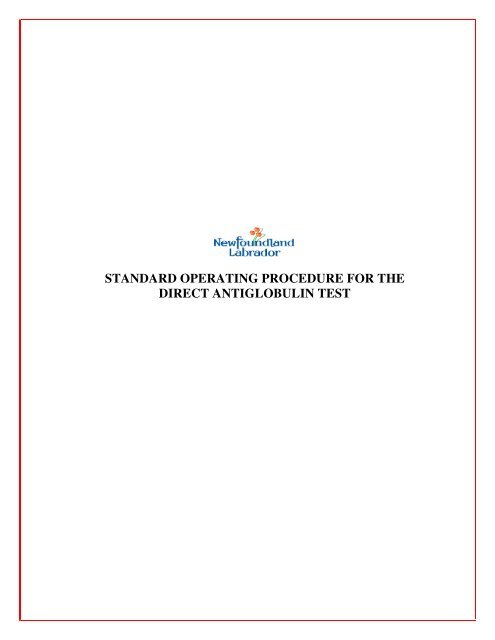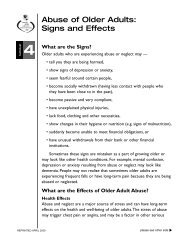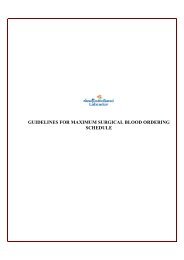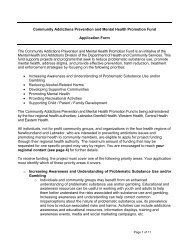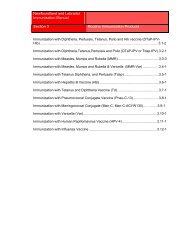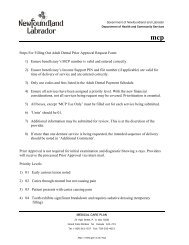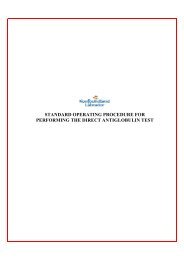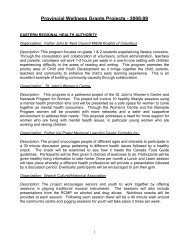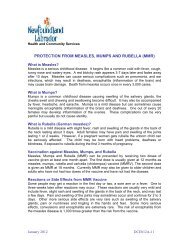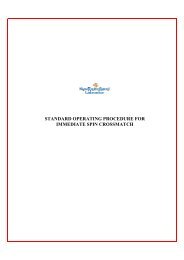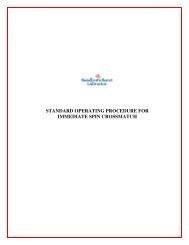standard operating procedure for the direct antiglobulin test
standard operating procedure for the direct antiglobulin test
standard operating procedure for the direct antiglobulin test
You also want an ePaper? Increase the reach of your titles
YUMPU automatically turns print PDFs into web optimized ePapers that Google loves.
STANDARD OPERATING PROCEDURE FOR THE<br />
DIRECT ANTIGLOBULIN TEST
Provincial Blood<br />
Coordinating Program<br />
Standard Operating Procedure For<br />
Per<strong>for</strong>ming The Direct Antiglobulin<br />
Test.<br />
TITLE: Standard Operating Procedure <strong>for</strong> Per<strong>for</strong>ming <strong>the</strong><br />
Direct Antiglobulin Test<br />
1.0 Principle<br />
To detect in vivo sensitization of red blood cells (RBC) and to determine which<br />
protein is coating red cells.<br />
A 3% saline suspension of <strong>the</strong> red blood cells to be <strong>test</strong>ed is washed with saline.<br />
Antiglobulin reagents, polyspecific (anti-IgG and C3) and/or monospecific (anti-<br />
IgG and anti-C3) antisera, are added to <strong>the</strong> washed red cell button, mixed,<br />
centrifuged and <strong>the</strong>n examined microscopically.<br />
2.0 Scope and Related Policies<br />
2.1 The facility shall develop and maintain <strong>operating</strong> <strong>procedure</strong>s <strong>for</strong> each<br />
activity that affects <strong>the</strong> safety of recipients.<br />
2.2 The facility’s SOP manual shall be available to all staff at all times to cover<br />
<strong>the</strong> activities <strong>the</strong>y per<strong>for</strong>m.<br />
2.3 Quality control shall be carried out as specified in an <strong>operating</strong> <strong>procedure</strong>.<br />
2.4 To provide work instruction <strong>for</strong> consistent <strong>test</strong>ing, interpretation and<br />
reporting of <strong>the</strong> Direct Antiglobulin Test (DAT).<br />
2.5 The Direct Antiglobulin Test (DAT) may be per<strong>for</strong>med <strong>for</strong> investigation of<br />
• Hemolytic disease of <strong>the</strong> newborn<br />
• Autoimmune hemolytic anemia<br />
• Transfusion reactions<br />
• Sensitization caused by drugs<br />
2.6 A DAT is required if an auto control is not done in <strong>the</strong> antibody screen and:<br />
• Antibody identification is required and an auto control cannot be done<br />
(e.g. limited volume of plasma)<br />
• Antigen typing of <strong>the</strong> patient cells is required<br />
2.7 The <strong>antiglobulin</strong> reagent shall contain antibodies to IgG and C3d component<br />
of complement. The only exception is cord blood <strong>test</strong>ing that may be<br />
per<strong>for</strong>med with a monospecific anti-IgG reagent.<br />
_______________________________________________________________________<br />
This document may be incorporated into each Regional Policy/Procedure Manual.<br />
NL09-005<br />
Version: 2.0<br />
Effective Date: 2011-02-14<br />
Page 2 of 12
Provincial Blood<br />
Coordinating Program<br />
Standard Operating Procedure For<br />
Per<strong>for</strong>ming The Direct Antiglobulin<br />
Test.<br />
2.8 If a <strong>direct</strong> <strong>antiglobulin</strong> <strong>test</strong> per<strong>for</strong>med on a clotted specimen identifies<br />
complement on <strong>the</strong> red cell surface, <strong>the</strong> result shall be verified using an<br />
EDTA sample.<br />
3.0 Specimens<br />
3.1 Blood sample collected in EDTA anticoagulant<br />
3.2 Clotted blood sample – Cells from a clotted specimen may be used.<br />
However, if <strong>the</strong> <strong>test</strong> is positive with anti-C3, it must be repeated with an<br />
EDTA specimen.<br />
4.0 Materials<br />
4.1 Polyspecific Antihuman globulin (AHG) reagent containing Anti-IgG and<br />
Anti-C3<br />
4.2 Monospecific Anti-IgG reagent<br />
4.3 Monospecific Anti-C3 reagent (anti -C3b, -C3d)<br />
4.4 IgG coated red cells (Coombs control)<br />
4.5 C3 coated red cells<br />
4.6 0.9% Normal saline<br />
4.7 Serologic centrifuge<br />
4.8 Cell washer<br />
4.9 Microscope<br />
4.10 Test tubes<br />
4.11 Transfer pipettes<br />
Note: A control reagent is required when agglutination is observed with all antisera<br />
<strong>test</strong>ed.<br />
5.0 Quality Control<br />
5.1 Test polyspecific and anti-IgG reagents against IgG coated cells, C3 coated<br />
cells and unsensitized cells at time of use or once daily as applicable.<br />
_______________________________________________________________________<br />
This document may be incorporated into each Regional Policy/Procedure Manual.<br />
NL09-005<br />
Version: 2.0<br />
Effective Date: 2011-02-14<br />
Page 3 of 12
Provincial Blood<br />
Coordinating Program<br />
6.0 Process Flowchart<br />
Standard Operating Procedure For<br />
Per<strong>for</strong>ming The Direct Antiglobulin<br />
Test.<br />
6.1 Process Flow – Testing with Polyspecific AHG<br />
_______________________________________________________________________<br />
This document may be incorporated into each Regional Policy/Procedure Manual.<br />
NL09-005<br />
Version: 2.0<br />
Effective Date: 2011-02-14<br />
Page 4 of 12
Provincial Blood<br />
Coordinating Program<br />
Standard Operating Procedure For<br />
Per<strong>for</strong>ming The Direct Antiglobulin<br />
Test.<br />
6.2 Process Flow– Testing with monospecific reagents<br />
_______________________________________________________________________<br />
This document may be incorporated into each Regional Policy/Procedure Manual.<br />
NL09-005<br />
Version: 2.0<br />
Effective Date: 2011-02-14<br />
Page 5 of 12
Provincial Blood<br />
Coordinating Program<br />
Standard Operating Procedure For<br />
Per<strong>for</strong>ming The Direct Antiglobulin<br />
Test.<br />
7.0 Procedure<br />
7.1 Procedure <strong>for</strong> Testing with Polyspecific AHG<br />
7.1.1 Check specimen suitability. Ensure patient in<strong>for</strong>mation on<br />
specimen matches requisition. (See NL2010-012 Determining<br />
Specimen Suitability)<br />
7.1.2 Check patient history. (See NL2010-013 Patient History<br />
Check)<br />
7.1.3 Wash an aliquot of red blood cells to be <strong>test</strong>ed at least once<br />
with normal saline. Prepare a red cell suspension in normal<br />
saline (concentration as indicated in manufacturer’s <strong>direct</strong>ions)<br />
7.1.4 Label 2 <strong>test</strong> tubes: one with patient identifier and AHG (eg. JD-<br />
AHG) and one with patient identifier and control (eg. JD-<br />
CTRL).<br />
Per<strong>for</strong>m <strong>the</strong> remaining steps without interruption.<br />
7.1.5 Dispense an aliquot (volume as indicated in manufacturer’s<br />
<strong>direct</strong>ions) of patient’s red cell suspension into each tube.<br />
7.1.6 Wash 4 times with saline. Completely decant saline after each<br />
wash and resuspend cells prior to <strong>the</strong> addition of saline <strong>for</strong><br />
subsequent washes.<br />
7.1.7 Completely decant saline after final wash, blot to remove any<br />
residual saline in order to obtain a ‘dry’ red cell button.<br />
7.1.8 Immediately add 2 drops (or volume indicated in<br />
manufacturer’s <strong>direct</strong>ions) of polyspecific AHG to tube<br />
labelled “AHG” and add 2 drops of saline to <strong>the</strong> tube labelled<br />
“CTRL”<br />
7.1.9 Mix and centrifuge (speed and time as recommended by<br />
manufacturer’s <strong>direct</strong>ions) .<br />
7.1.10 Immediately after centrifugation re-suspend red blood cells and<br />
examine macroscopically <strong>for</strong> agglutination. If negative<br />
macroscopically, read microscopically.<br />
7.1.11 Grade and record <strong>the</strong> results.<br />
7.1.12 If negative, incubate <strong>test</strong> at room temperature <strong>for</strong> 5 minutes<br />
7.1.13 After incubation mix and centrifuge, re-suspend <strong>the</strong> red cells,<br />
read macroscopically and microscopically.<br />
7.1.14 Grade and record results.<br />
7.1.15 If <strong>test</strong> is negative add 1 drop (or volume indicated in<br />
manufacturer’s <strong>direct</strong>ions) of IgG coated red cells to <strong>the</strong> tube<br />
labelled “AHG”and centrifuge.<br />
7.1.16 Examine <strong>the</strong> tube <strong>for</strong> macroscopic agglutination.<br />
7.1.17 Grade and record results.<br />
_______________________________________________________________________<br />
This document may be incorporated into each Regional Policy/Procedure Manual.<br />
NL09-005<br />
Version: 2.0<br />
Effective Date: 2011-02-14<br />
Page 6 of 12
Provincial Blood<br />
Coordinating Program<br />
Standard Operating Procedure For<br />
Per<strong>for</strong>ming The Direct Antiglobulin<br />
Test.<br />
NOTE: If agglutination (must be at least 2+) following <strong>the</strong> addition of IgG<br />
coated red cells is not detected <strong>the</strong> <strong>test</strong> is invalid and must be<br />
repeated.<br />
If <strong>test</strong> with polyspecific AHG is positive, sample must be <strong>test</strong>ed<br />
with monospecific Anti-IgG and Anti-C3.<br />
7.2 Procedure <strong>for</strong> Testing with Monospecific Anti-IgG and Anti C3d<br />
7.2.1 Check specimen suitability. Ensure patient in<strong>for</strong>mation on<br />
specimen matches requisition. (See NL2010-012 Determining<br />
Specimen Suitability)<br />
7.2.2 Check patient history. (See NL2010-013 Patient History<br />
Check)<br />
7.2.3 Label 3 <strong>test</strong> tubes: one with patient identifier and IgG, one with<br />
patient identifier and C3 and one with patient identifier and<br />
control (CTRL).<br />
Per<strong>for</strong>m <strong>the</strong> remaining steps without interruption<br />
7.2.4 Dispense an aliquot (volume as indicated in manufacturer’s<br />
<strong>direct</strong>ions) of previously prepared patient red cell suspension<br />
into each tube and wash 4 times with saline. Completely decant<br />
saline after each wash and resuspend cells prior to <strong>the</strong> addition<br />
of saline <strong>for</strong> subsequent washes.<br />
7.2.5 Completely decant saline after final wash, blot to remove any<br />
residual saline in order to obtain a ‘dry’ red cell button.<br />
7.2.6 Immediately add 2 drops (or volume indicated in<br />
manufacturer’s <strong>direct</strong>ions) of IgG to <strong>the</strong> tube labelled “IgG”, 2<br />
drops of C3 (or volume indicated in manufacturer’s <strong>direct</strong>ions)<br />
to <strong>the</strong> tube labelled “C3” and 2 drops of saline to <strong>the</strong> tube<br />
labelled “CTRL”.<br />
7.2.7 Mix and centrifuge (speed and time as recommended by<br />
manufacturer’s <strong>direct</strong>ions) .<br />
7.2.8 Immediately after centrifugation re-suspend red blood cells and<br />
examine macroscopically <strong>for</strong> agglutination. If negative<br />
macroscopically, examine <strong>the</strong> cells microscopically.<br />
7.2.9 Grade and record <strong>the</strong> results.<br />
_______________________________________________________________________<br />
This document may be incorporated into each Regional Policy/Procedure Manual.<br />
NL09-005<br />
Version: 2.0<br />
Effective Date: 2011-02-14<br />
Page 7 of 12
Provincial Blood<br />
Coordinating Program<br />
Standard Operating Procedure For<br />
Per<strong>for</strong>ming The Direct Antiglobulin<br />
Test.<br />
IgG<br />
C3<br />
Positive<br />
Report<br />
result<br />
Report<br />
result<br />
Negative<br />
• add 1 drop IgG coated red cells<br />
• mix and centrifuge<br />
• read macroscopically<br />
• grade and record results<br />
• report result<br />
• incubate “C3” and “CTRL”<br />
tubes at room temperature 5 minutes<br />
• mix and centrifuge<br />
• read macroscopically and microscopically<br />
• grade and record result<br />
▪ if still negative, add 1 drop C3 coated<br />
red cells<br />
▪ mix and centrifuge<br />
▪ read macroscopically<br />
▪ grade and record results<br />
▪ report result<br />
NOTE: If agglutination following <strong>the</strong> addition of <strong>the</strong> appropriate check<br />
cells is not detected <strong>the</strong> <strong>test</strong> is invalid and must be repeated<br />
8.0 Reporting / Interpretation<br />
8.1 Interpretation using Polyspecific AHG reagents:<br />
Polyspecific Control Test Result Interpretation<br />
AHG<br />
Negative Negative Negative<br />
Positive Negative Positive. Test with monospecific reagents.<br />
Positive Positive Unable to report. See note<br />
_______________________________________________________________________<br />
This document may be incorporated into each Regional Policy/Procedure Manual.<br />
NL09-005<br />
Version: 2.0<br />
Effective Date: 2011-02-14<br />
Page 8 of 12
Provincial Blood<br />
Coordinating Program<br />
Standard Operating Procedure For<br />
Per<strong>for</strong>ming The Direct Antiglobulin<br />
Test.<br />
8.2 Interpretation using Monospecific <strong>antiglobulin</strong> reagents:<br />
Anti-IgG Anti-<br />
Control Test Result Interpretation<br />
Complement<br />
Negative Negative Negative Negative<br />
Positive Positive Negative Positive – IgG and Complement coating<br />
cells<br />
Positive Negative Negative Positive – IgG coating cells<br />
Negative Positive Negative Positive – Complement coating cells<br />
Negative TNP Negative Neonate specimens only: Negative<br />
Positive TNP Negative Neonate specimens only: Positive – IgG<br />
coating cells<br />
Positive Positive or Positive Unable to report See note<br />
TNP<br />
*TNP - Test not per<strong>for</strong>med<br />
9.0 Procedural Notes<br />
9.1 Invalid <strong>test</strong>s<br />
9.1.1 The addition of IgG control cells should demonstrate a 2+<br />
reaction or <strong>the</strong> <strong>test</strong> is invalid and shall be repeated.<br />
9.1.2 The addition of complement control cells should demonstrate a<br />
1+ reaction or <strong>the</strong> <strong>test</strong> is invalid and shall be repeated.<br />
9.2 False Negative <strong>test</strong><br />
9.2.1 Tests should be read immediately after centrifugation. Delay<br />
may cause bound IgG to dissociate from <strong>the</strong> red cells causing<br />
false negative results.<br />
9.3 False Positive <strong>test</strong><br />
9.3.1 False positive <strong>test</strong> results due to in vitro coating with<br />
complement may occur if <strong>test</strong>ing is per<strong>for</strong>med on a clotted<br />
specimen.<br />
9.4 Positive Control<br />
9.4.1 A positive control may be due to strong cold agglutinin in <strong>the</strong><br />
recipient’s serum/plasma. Wash recipient cells with 37°C and<br />
repeat DAT.<br />
9.5 Mixed Field Reaction<br />
9.5.1 Mixed Field reaction may indicate a transfusion reaction.<br />
9.6 Weak Anti-complement Reactions<br />
9.6.1 Weak anti-complement reactions may be enhanced if tubes<br />
containing polyspecific AHG /red cells or anti-complement /<br />
red cells are incubated <strong>for</strong> 5 minutes at room temperature after<br />
initial reading of <strong>the</strong> <strong>test</strong>. Centrifuge and read again.<br />
_______________________________________________________________________<br />
This document may be incorporated into each Regional Policy/Procedure Manual.<br />
NL09-005<br />
Version: 2.0<br />
Effective Date: 2011-02-14<br />
Page 9 of 12
Provincial Blood<br />
Coordinating Program<br />
Standard Operating Procedure For<br />
Per<strong>for</strong>ming The Direct Antiglobulin<br />
Test.<br />
10.0 Records Management<br />
10.1 The recipient transfusion data file in <strong>the</strong> transfusion service laboratory shall<br />
be retained indefinitely.<br />
10.2 All transfusion records in <strong>the</strong> recipient’s medical chart, shall be retained in<br />
accordance with health care facility’s retention policy <strong>for</strong> medical records.<br />
10.3 Quality control of blood components, blood products, reagents and<br />
equipment shall be retained <strong>for</strong> 5 years.<br />
10.4 Date and time of specimen collection and phlebotomist’s identification shall<br />
be retained <strong>for</strong> 1 year.<br />
10.5 Request <strong>for</strong>m <strong>for</strong> serologic <strong>test</strong>s shall be retained <strong>for</strong> one month.<br />
10.6 Documentation of staff training and competency must be kept <strong>for</strong> a<br />
minimum of ten years.<br />
10.7 Refer to CSTM Standards, Appendix A and CSA Standards, Table 4 <strong>for</strong><br />
additional record retention requirements.<br />
_______________________________________________________________________<br />
This document may be incorporated into each Regional Policy/Procedure Manual.<br />
NL09-005<br />
Version: 2.0<br />
Effective Date: 2011-02-14<br />
Page 10 of 12
Provincial Blood<br />
Coordinating Program<br />
Standard Operating Procedure For<br />
Per<strong>for</strong>ming The Direct Antiglobulin<br />
Test.<br />
11.0 References<br />
11.1 American Association of Blood Banks. Standards <strong>for</strong> blood banks and<br />
transfusion services, 26 th ed, Be<strong>the</strong>sda, Maryland: American Association of<br />
Blood Banks; 2009.<br />
11.2 Becher M. Technical manual. 15 th ed. Be<strong>the</strong>sda, Maryland:<br />
American Association of Blood Banks; 2005.<br />
11.3 Canadian Standards Association. Blood and blood components Z902-10.<br />
Mississauga (ON): Canadian Standards Association; 2010.<br />
11.4 Canadian Standards <strong>for</strong> Transfusion Medicine. CSTM <strong>standard</strong>s <strong>for</strong> hospital<br />
transfusion services Version 2.0. Ottawa: Canadian Society <strong>for</strong> Transfusion<br />
Medicine; 2007.<br />
11.5 Dominion Biologicals Limited. Anti-Human Globulin Novaclone TM<br />
Anti-C3d monoclonal blend manufactures’ instructions. Dartmouth (NS):<br />
Dominion Biologicals Limited; 2007.<br />
11.6 Dominion Biologicals Limited. Anti-Human Globulin Novaclone TM<br />
Anti-IgG, –C3d polyspecific manufactures’ instructions. Dartmouth (NS):<br />
Dominion Biologicals Limited; 2008.<br />
11.7 Dominion Biologicals Limited. Anti-Human Globulin Novaclone TM<br />
Anti- IgG monoclonal blend manufactures’ instructions. Dartmouth (NS):<br />
Dominion Biologicals Limited; 2008.<br />
11.8 Immucor Inc. Checkcell® (Weak) <strong>antiglobulin</strong> control IgG-coated pooled<br />
red blood cells manufacture’s instructions. Norcross,(GA) USA: Immucor<br />
Gamma; 2007<br />
11.9 Immucor Inc. Complement control cells manufacture’s instructions.<br />
Norcross,(GA) USA: Immucor Gamma; 2005.<br />
11.10 Ortho-Clinical Diagnostics, Inc. Anti-human globulin Anti-C3d<br />
monoclonal blend manufactures’ instructions. Raritan (NJ): Ortho-Clinical<br />
Diagnostics, Inc.; 1999.<br />
_______________________________________________________________________<br />
This document may be incorporated into each Regional Policy/Procedure Manual.<br />
NL09-005<br />
Version: 2.0<br />
Effective Date: 2011-02-14<br />
Page 11 of 12
Provincial Blood<br />
Coordinating Program<br />
Standard Operating Procedure For<br />
Per<strong>for</strong>ming The Direct Antiglobulin<br />
Test.<br />
11.11 Ortho-Clinical Diagnostics, Inc. Anti-human globulin BioClone® Anti-<br />
IgG, -C3d polyspecific manufactures’ instructions. Raritan (NJ): Ortho-<br />
Clinical Diagnostics, Inc.; 2005.<br />
11.12 Ortho-Clinical Diagnostics, Inc. Anti-human globulin BioClone® Anti-<br />
IgG manufactures’ instructions. Raritan (NJ): Ortho-Clinical Diagnostics,<br />
Inc.; 2005.<br />
11.13 Ortho-Clinical Diagnostics, Inc. Reagent red blood cells Ortho® Coombs<br />
Control manufacture’s instructions. Raritan (NJ): Ortho-Clinical<br />
Diagnostics, Inc.; 2007<br />
11.14 Manitoba Provincial Blood Coordinating Office. Manitoba transfusion<br />
quality manual <strong>for</strong> blood banks Version 2.0. Winnipeg (MB).Manitoba<br />
Provincial Blood Programs Coordinating Office; 2007.<br />
11.15 Transfusion Ontario Programs Ottawa Office. Ontario regional blood<br />
coordinating network <strong>standard</strong> work instruction manual. Ottawa (ON):<br />
Transfusion Ontario Programs Ottawa Office; 2009.<br />
11.16 TraQ Program of <strong>the</strong> British Columbia Provincial Blood Coordinating<br />
Office. Technical resource manual <strong>for</strong> hospital transfusion services, 2 nd<br />
edition. British Columbia: British Columbia Provincial Blood<br />
Coordinating Office; 2005.<br />
_______________________________________________________________________<br />
This document may be incorporated into each Regional Policy/Procedure Manual.<br />
NL09-005<br />
Version: 2.0<br />
Effective Date: 2011-02-14<br />
Page 12 of 12


